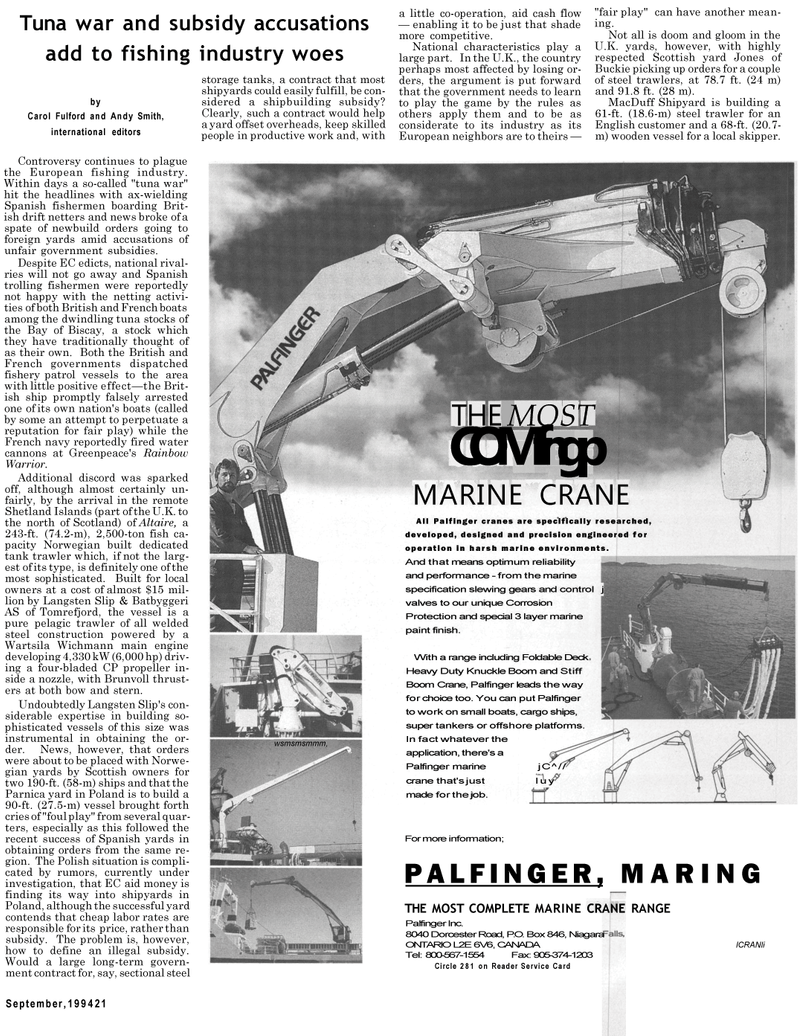
Page 19: of Maritime Reporter Magazine (September 1994)
Read this page in Pdf, Flash or Html5 edition of September 1994 Maritime Reporter Magazine
THE MOST COMfngp
MARINE CRANE
MARING
All Palfinger cranes are specifically researched, developed, designed and precision engineered for operation in harsh marine environments.
And that means optimum reliability and performance - from the marine specification slewing gears and control j valves to our unique Corrosion
Protection and special 3 layer marine paint finish.
With a range including Foldable Deck
Heavy Duty Knuckle Boom and Stiff
Boom Crane, Palfinger leads the way for choice too. You can put Palfinger to work on small boats, cargo ships, super tankers or offshore platforms.
In fact whatever the application, there's a
Palfinger marine jC^// crane that's just luy made for the job. wsmsmsmmm,
Tuna war and subsidy accusations add to fishing industry woes by
Carol Fulford and Andy Smith, international editors storage tanks, a contract that most shipyards could easily fulfill, be con- sidered a shipbuilding subsidy?
Clearly, such a contract would help a yard offset overheads, keep skilled people in productive work and, with a little co-operation, aid cash flow — enabling it to be just that shade more competitive.
National characteristics play a large part. In the U.K., the country perhaps most affected by losing or- ders, the argument is put forward that the government needs to learn to play the game by the rules as others apply them and to be as considerate to its industry as its
European neighbors are to theirs — "fair play" can have another mean- ing.
Not all is doom and gloom in the
U.K. yards, however, with highly respected Scottish yard Jones of
Buckie picking up orders for a couple of steel trawlers, at 78.7 ft. (24 m) and 91.8 ft. (28 m).
MacDuff Shipyard is building a 61-ft. (18.6-m) steel trawler for an
English customer and a 68-ft. (20.7- m) wooden vessel for a local skipper.
Controversy continues to plague the European fishing industry.
Within days a so-called "tuna war" hit the headlines with ax-wielding
Spanish fishermen boarding Brit- ish drift netters and news broke of a spate of newbuild orders going to foreign yards amid accusations of unfair government subsidies.
Despite EC edicts, national rival- ries will not go away and Spanish trolling fishermen were reportedly not happy with the netting activi- ties of both British and French boats among the dwindling tuna stocks of the Bay of Biscay, a stock which they have traditionally thought of as their own. Both the British and
French governments dispatched fishery patrol vessels to the area with little positive effect—the Brit- ish ship promptly falsely arrested one of its own nation's boats (called by some an attempt to perpetuate a reputation for fair play) while the
French navy reportedly fired water cannons at Greenpeace's Rainbow
Warrior.
Additional discord was sparked off, although almost certainly un- fairly, by the arrival in the remote
Shetland Islands (part of the U.K. to the north of Scotland) of Altaire, a 243-ft. (74.2-m), 2,500-ton fish ca- pacity Norwegian built dedicated tank trawler which, if not the larg- est of its type, is definitely one of the most sophisticated. Built for local owners at a cost of almost $15 mil- lion by Langsten Slip & Batbyggeri
AS of Tomrefjord, the vessel is a pure pelagic trawler of all welded steel construction powered by a
Wartsila Wichmann main engine developing 4,330 kW (6,000 hp) driv- ing a four-bladed CP propeller in- side a nozzle, with Brunvoll thrust- ers at both bow and stern.
Undoubtedly Langsten Slip's con- siderable expertise in building so- phisticated vessels of this size was instrumental in obtaining the or- der. News, however, that orders were about to be placed with Norwe- gian yards by Scottish owners for two 190-ft. (58-m) ships and that the
Parnica yard in Poland is to build a 90-ft. (27.5-m) vessel brought forth cries of "foul play" from several quar- ters, especially as this followed the recent success of Spanish yards in obtaining orders from the same re- gion. The Polish situation is compli- cated by rumors, currently under investigation, that EC aid money is finding its way into shipyards in
Poland, although the successful yard contends that cheap labor rates are responsible for its price, rather than subsidy. The problem is, however, how to define an illegal subsidy.
Would a large long-term govern- ment contract for, say, sectional steel
September, 1994 21
For more information; lCRANli
PALFINGER,
THE MOST COMPLETE MARINE CRANE RANGE
Palfinger Inc. 8040 Dorcester Road, P.O. Box 846, Niagara
ONTARIO L2E 6V6, CANADA
Tel: 800-567-1554 Fax: 905-374-1203
Circle 281 on Reader Service Card

 18
18

 20
20
